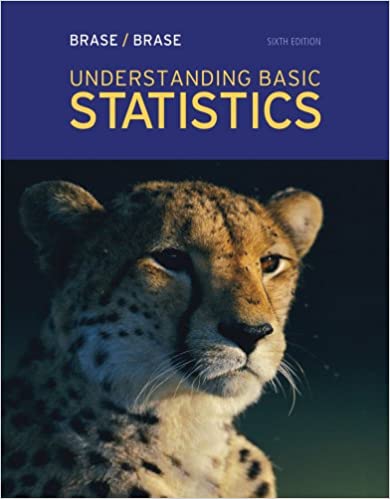
Understanding Basic Statistics 6th Edition by Charles Henry Brase,Corrinne Pellillo Brase
Edition 6ISBN: 978-1111827021
Understanding Basic Statistics 6th Edition by Charles Henry Brase,Corrinne Pellillo Brase
Edition 6ISBN: 978-1111827021 Exercise 81
Provide the following information
(a) What is the level of significance State the null and alternate hypotheses.
(b) Check Requirements What sampling distribution will you use Explain the rationale for your choice of sampling distribution. Compute the value of the sample test statistic.
(c) Find (or estimate) the P -value. Sketch the sampling distribution and show the area corresponding to the P -value.
(d) Based on you answers in part (a) to (c), will you reject or fail to reject the null hypothesis Are the data statistically significant at level
(e) Interpret your conclusion in the context of the application.
Note: For degree of freedom d.f. not given in the Student's t table, use the closest d.f. that is smaller. In some situations, this choice of d.f. may increase the P -value by a small amount and therefore produce a slightly more "conservative" answer.
Investing: Stocks Socially conscious investors screen out stocks of alcohol and tobacco makers, firms with poor environmental records, and companies with poor labor practices. Some examples of "good," socially conscious companies are Johnson and Johnson, Dell Computers, Bank of America, and Home Depot. The question is, are such stocks overpriced One measure of value is the P/E, or price-to-earnings ratio. High P/E ratios may indicate a stock is overpriced. For the S P stock index of all major stocks, the mean P/E ratio is = 19.4. A random sample of 36 "socially conscious" stocks gave a P/E ratio sample mean of
 = 17.9, with sample standard deviation s = 5.2. Does this indicate that the mean P/E ratio of all socially conscious stocks is different (either way) from the mean P/E ratio of the S P stock index Use = 0.05.
= 17.9, with sample standard deviation s = 5.2. Does this indicate that the mean P/E ratio of all socially conscious stocks is different (either way) from the mean P/E ratio of the S P stock index Use = 0.05.
(a) What is the level of significance State the null and alternate hypotheses.
(b) Check Requirements What sampling distribution will you use Explain the rationale for your choice of sampling distribution. Compute the value of the sample test statistic.
(c) Find (or estimate) the P -value. Sketch the sampling distribution and show the area corresponding to the P -value.
(d) Based on you answers in part (a) to (c), will you reject or fail to reject the null hypothesis Are the data statistically significant at level
(e) Interpret your conclusion in the context of the application.
Note: For degree of freedom d.f. not given in the Student's t table, use the closest d.f. that is smaller. In some situations, this choice of d.f. may increase the P -value by a small amount and therefore produce a slightly more "conservative" answer.
Investing: Stocks Socially conscious investors screen out stocks of alcohol and tobacco makers, firms with poor environmental records, and companies with poor labor practices. Some examples of "good," socially conscious companies are Johnson and Johnson, Dell Computers, Bank of America, and Home Depot. The question is, are such stocks overpriced One measure of value is the P/E, or price-to-earnings ratio. High P/E ratios may indicate a stock is overpriced. For the S P stock index of all major stocks, the mean P/E ratio is = 19.4. A random sample of 36 "socially conscious" stocks gave a P/E ratio sample mean of
 = 17.9, with sample standard deviation s = 5.2. Does this indicate that the mean P/E ratio of all socially conscious stocks is different (either way) from the mean P/E ratio of the S P stock index Use = 0.05.
= 17.9, with sample standard deviation s = 5.2. Does this indicate that the mean P/E ratio of all socially conscious stocks is different (either way) from the mean P/E ratio of the S P stock index Use = 0.05.Explanation
a)
b)
Since,
this is a two tailed ...
Understanding Basic Statistics 6th Edition by Charles Henry Brase,Corrinne Pellillo Brase
Why don’t you like this exercise?
Other Minimum 8 character and maximum 255 character
Character 255


